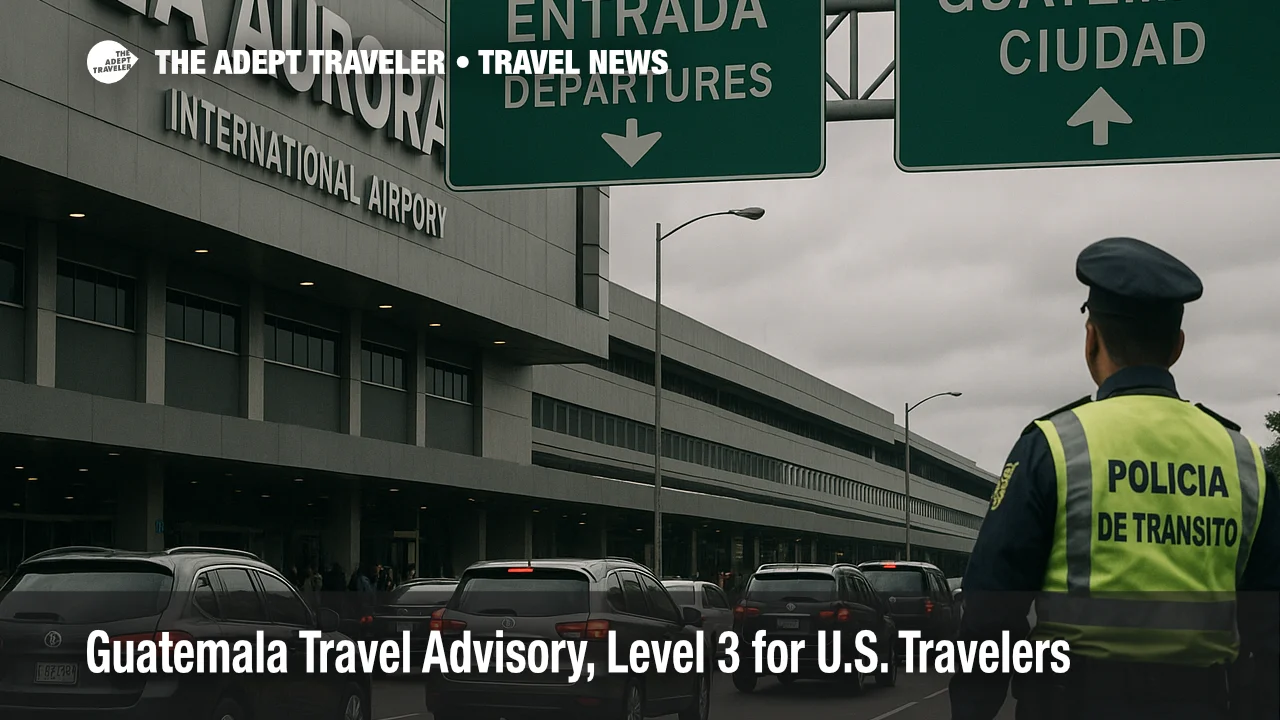Guatemala Travel Advisory, Level 3 for U.S. Travelers

Key points
- U.S. Department of State lists Guatemala as Level 3, Reconsider Travel, due to crime
- Do not travel areas include Zone 18 in Guatemala City and the city of Villa Nueva
- Canada advises a high degree of caution and warns of illegal roadblocks to La Aurora International Airport
- Build extra time into airport transfers, monitor local news, and avoid protest areas even if they look calm
Impact
- Do-Not-Travel Areas
- Avoid Zone 18 in Guatemala City and Villa Nueva entirely
- Airport Transfers
- Plan additional time to reach La Aurora International Airport, routes can be blocked
- Route Planning
- Monitor local news and traffic updates, be ready to reroute
- Personal Security
- Use vetted transport, minimize visible valuables, and avoid night travel
- Documentation
- Review official advisories before booking or transiting through Guatemala City
U.S. travelers should note that Guatemala is currently rated Level 3, Reconsider Travel, by the U.S. Department of State due to crime. The advisory includes specific do-not-travel areas, notably Zone 18 in Guatemala City and the city of Villa Nueva. Travelers should review the full advisory before booking or transiting through Guatemala City, and adjust plans accordingly. Canada separately advises exercising a high degree of caution, emphasizing that illegal roadblocks and demonstrations occur countrywide and can include the main roads that lead to La Aurora International Airport, Guatemala's primary international gateway. Build extra time into airport transfers, monitor local news, and avoid protest areas even if they appear peaceful. Together, these notices point to a higher likelihood of delays, detours, and security-driven changes for itineraries that touch Guatemala City.
Advisory overview
The U.S. advisory is straightforward. Guatemala is Level 3, which means the State Department recommends that travelers reconsider a trip because of higher-than-usual safety risks. Within that national rating, selected locations carry Level 4, Do Not Travel. These include Zone 18 in Guatemala City and the separate municipality of Villa Nueva. The same page also lists the departments of San Marcos and Huehuetenango, aside from their namesake cities, as Level 4 due to crime. If any portion of your route touches these areas, reroute or adjust timing to bypass them.
What Canada is telling its citizens
Canada's travel advice aligns on elevated risk and adds operational detail that directly affects flight plans. Officials warn that illegal roadblocks and demonstrations are frequent, and they can appear on the main roads that connect Guatemala City with La Aurora International Airport. In practice, this means that a transfer that normally takes 30 to 60 minutes can stretch far longer, or be cut off entirely, with little notice. The advisory recommends building additional time into airport transfers, avoiding travel at night, and being ready to change plans if roads close. That is pragmatic guidance for U.S. travelers as well.
Planning implications for air and ground
If you are connecting through Guatemala City, confirm that your ground transport is flexible and vetted, then add buffer time on both arrival and departure legs. When possible, schedule flights at times when traffic is lighter, and arrange pickups with hotel-vetted providers or authorized airport taxis rather than hailing cars on the street. If you must cross areas close to Zone 18 or Villa Nueva, ask your provider to confirm a route that avoids those zones, and keep a backup plan. Build in margin for checkpoints, slowdowns near demonstrations, and any weather-related issues that could amplify congestion. If your plans include overland travel to tourist areas such as Antigua or Lake Atitlán, travel in daylight, use reputable operators, and carry copies of key documents rather than originals except when required.
Background, how the system works
The State Department's four-level scale runs from Level 1, Exercise Normal Precautions, to Level 4, Do Not Travel. A country can carry one national level and still contain higher-risk sub-regions that are designated Level 4. Canada's system is similar in spirit, with "Exercise a high degree of caution" signaling notable safety concerns even when outright travel bans are not in effect. Both systems are living documents, updated as conditions evolve, so the most accurate picture comes from reviewing the primary pages before you book and again as your departure nears.
Final thoughts
The headline is clear. Guatemala is Level 3 for U.S. travelers, with Level 4 no-go areas in parts of Guatemala City and nearby Villa Nueva. Canada flags illegal roadblocks to the airport that can derail even well-planned itineraries. If your trip requires transiting Guatemala City, treat transfer time as a risk factor, confirm vetted transport, and keep routes flexible. Review the primary advisories in the days before departure, then travel with backup options and realistic buffers.
